Topping LA90 In-Depth Review – Block Rockin’ Beats
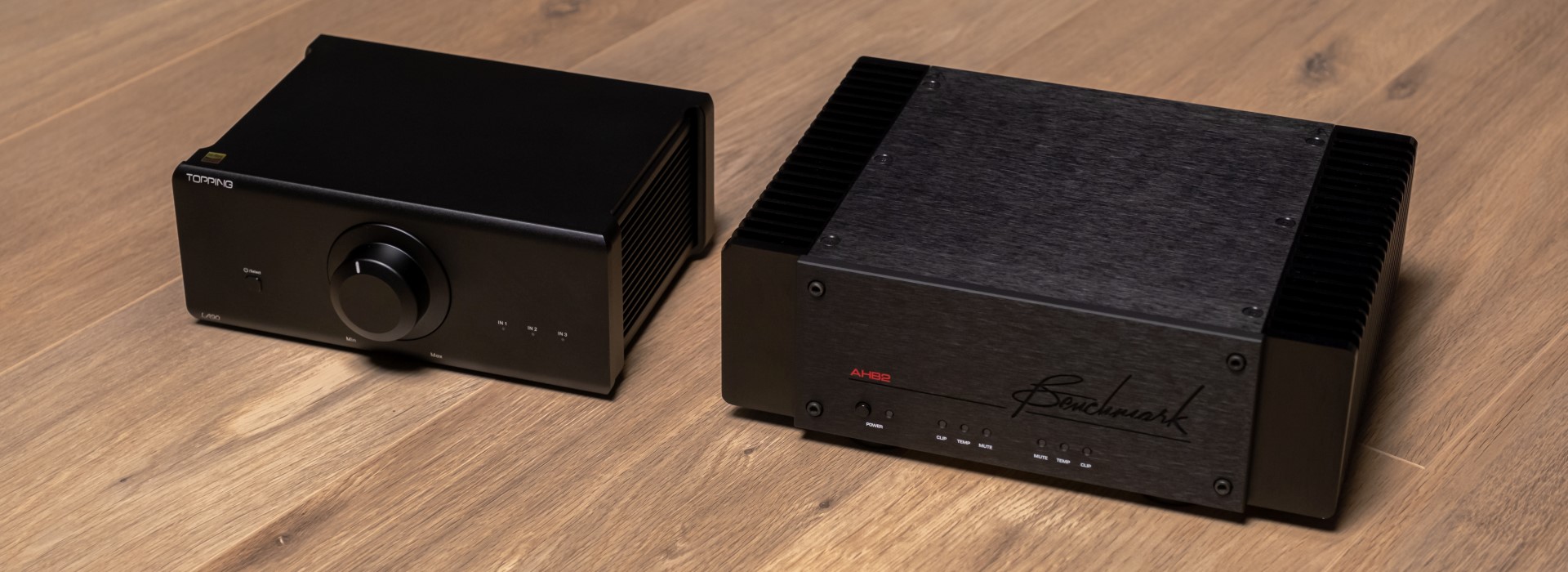
My Video Review:
There’s a sneaky HiFi maker from China that always pushed the envelope of affordable HiFi year after year. There’s something that drags my attention to Topping and to their doings. Maybe it’s their no-BS approach to marketing, their straightforward user manuals that contain detailed measurements, their audio performance and affordable price tags or…maybe all of the above makes them easy to like and recommend. Their D/A converters still have the highest values, making some of the biggest splashes in Hi-Fi communities around the world. Without Topping, we probably wouldn’t have a fierce competition and we would still think that paying more than $1K for a DAC, headphone or integrated amp would be mandatory for nicer sonics.
In recent years, Topping fully upgraded their arsenal with fresh new devices ranging from peanuts money Hi-Fi, to affordable and then to high-performance audio. Their entire range was updated with fresh new electronics, except for integrated and power amplifiers that were still lagging behind.
After exchanging several emails and explaining what’s important for the 21-century audiophile, things escalated fast, as in less than a year, three integrated amplifiers were released from the house of Topping. PA3S, PA5 and MX5 were road openers for the storm that was arising on the horizon, but a single flagship was still missing from their entire portfolio. Something that would look and perform in a similar fashion to their top-grade D90SE and PRE90 units. After a troubled design phase and long development time, a time came to unveil their flagship integrated/power amplifier that was simply called LA90.
LA90 follows the rest of the 90 series down to the smallest details, reeking bad attitude and carrying enough power under its belt, all placed in a nicely crafted unibody case. Today, I’ll be turning my attention towards their best power/integrated amplifier that goes for $899. Could Topping deliver a resembling performance to the rest of the 90 series or will it lag behind and be forgotten? All will be revealed soon. In a typical (overkill) fashion, I will be going deep into the rabbit hole and in the latest chapters of this review I’ll be comparing it with my daily driver Benchmark AHB2 power amplifier. Be sure to check that out and until that happens, let’s unbox this bad boy.
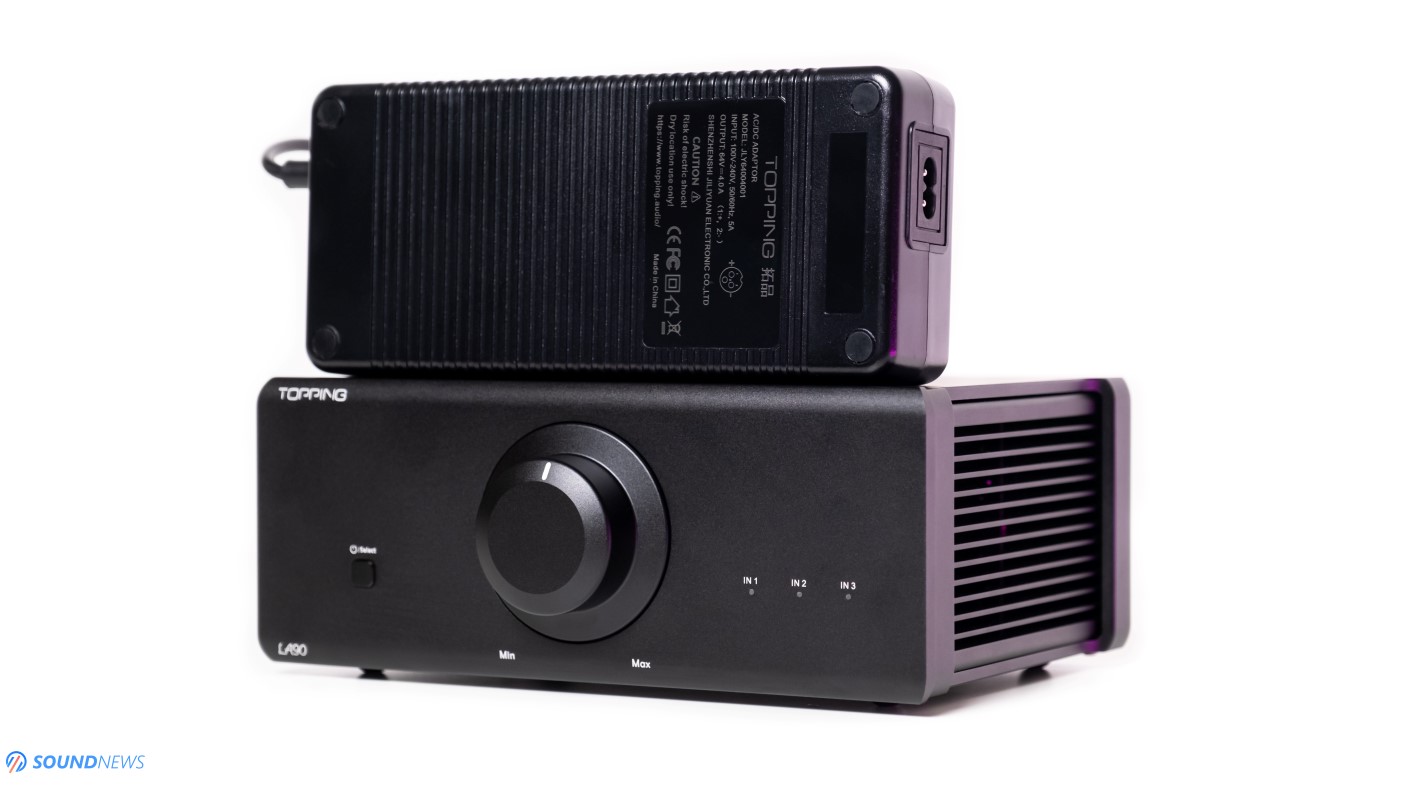
Unboxing & Package Contents
A box in a box is exactly how LA90 arrived at my front door, a usual sight that should well protect the unit during shipping. As all other Topping units that came before it, LA90 is protected all-around by layers of foam making sure it will arrive safe and sound to your front door. Topping always provided detailed measurements for their devices, performed by one of the nicest audio analyzers out there and I always liked that. Starting with frequency response, total-harmonic-distortion and finishing with FFT spectrum and multitone tests, everything can be found in its user manual. Apart from the unit itself, you’ll find a jumper cable (just in case you’ll want to use it as a mono amplifier), an external 256-Watt switching mode power supply, a power cable, a user manual and a warranty card that doubles as a product catalogue.
Topping describes it as an Ultra High-Performance Power Amplifier, but it can work as an integrated amplifier too, controlling power output with a volume wheel located on the front plate. As a stand-alone integrated amplifier, the only thing that is missing from the package is a remote control.
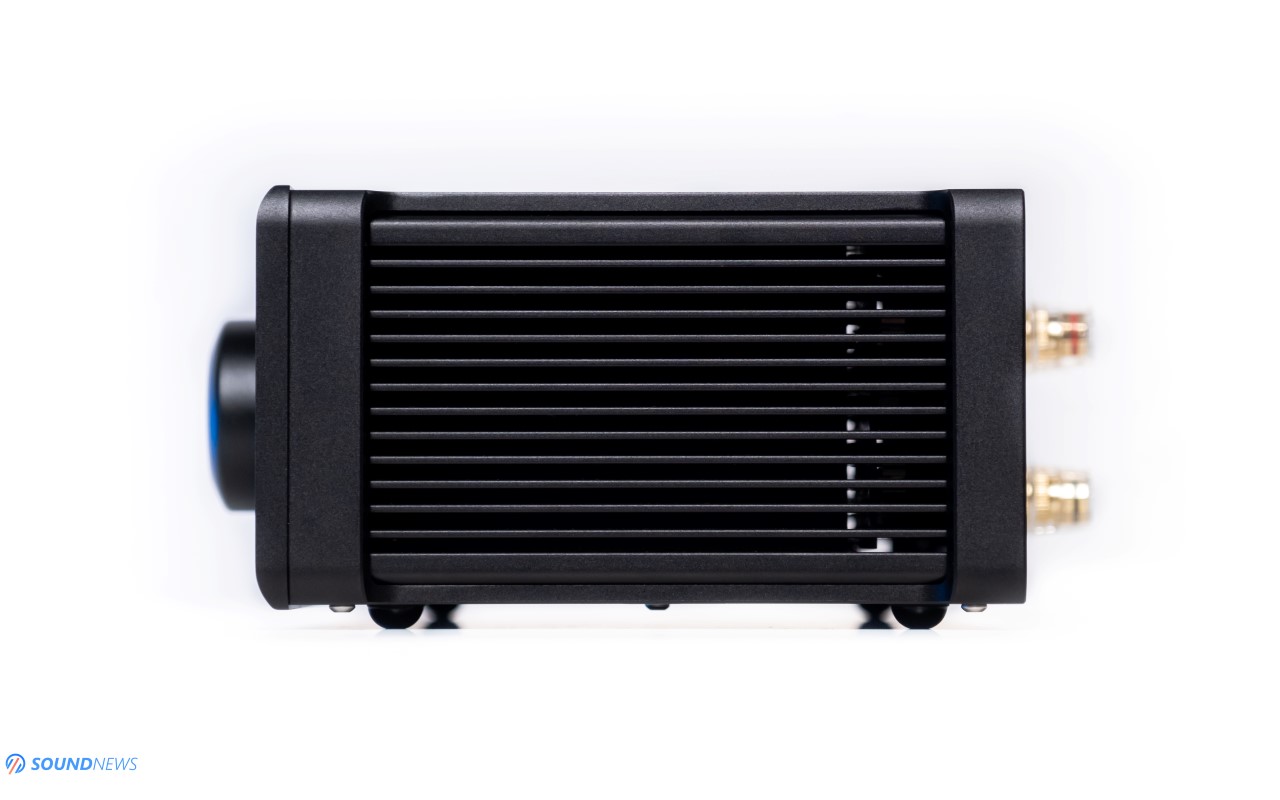
Design & Build Quality
While it looks plain and simple, I really dig its minimalist case. It follows the same design cues of their flagship units like D90SE, A90 and PRE90. You are looking at an unibody case that was carved from a single block of aluminum, with two metal plates attached to its back and front and with two aluminum heatsinks attached to its sides, that will improve heat dissipation. Thanks to its side mounted heat dissipation fins, LA90 runs cool when idle and it remains as cool under most load conditions. It can get a little warmer under harder loads, but it was never hot under any circumstances.
The front plate is much thicker, a common practice in the Hi-Fi world to eliminate wireless interference. The whole body has rounded corners and smooth lines, so you won’t cut yourself or damage your precious equipment while handling them around. I’m not spotting screws all around it, adding some sex appeal to the whole affair. The CNC milled front plate houses just a single On/Off/Input Selector button and several low-intensity LEDs will be showing the selected analog input. Underneath it four rubber feet can be spotted; placed in perfectly cut round spaces, these won’t budge when rearranging it on your rack. You can have it in either matte black (my review unit) or matte silver and in both cases, it rocks a higher WAF, since there’s only a single low-intensity LED when the unit is powered on. Weighting around ~2.75 kg (~6 lbs.) and measuring 220 cm wide by 205 mm deep and 90 mm tall, LA90 has the right size to be used in tight spaces.
The amp has a small foot-print, it’s smaller than KECES S300 and S125 units, much smaller than my former Kinki Studio EX-M7, Hegel H190 and Cambridge Audio Azur 851A and it’s a little smaller to my daily driver Benchmark AHB2 power amplifier. Being so small and compact, you can integrate it into tiny racks and petite Hi-Fi systems and you can see that an IKEA BESTA TV bench can support two LA90 units on a single shelf. All in all, LA90 looks like a huge space saver, something I can’t say about my former amplifiers.
All in all, Topping cared for the look and build-quality of their units and that can be immediately felt while closely inspecting the unit.
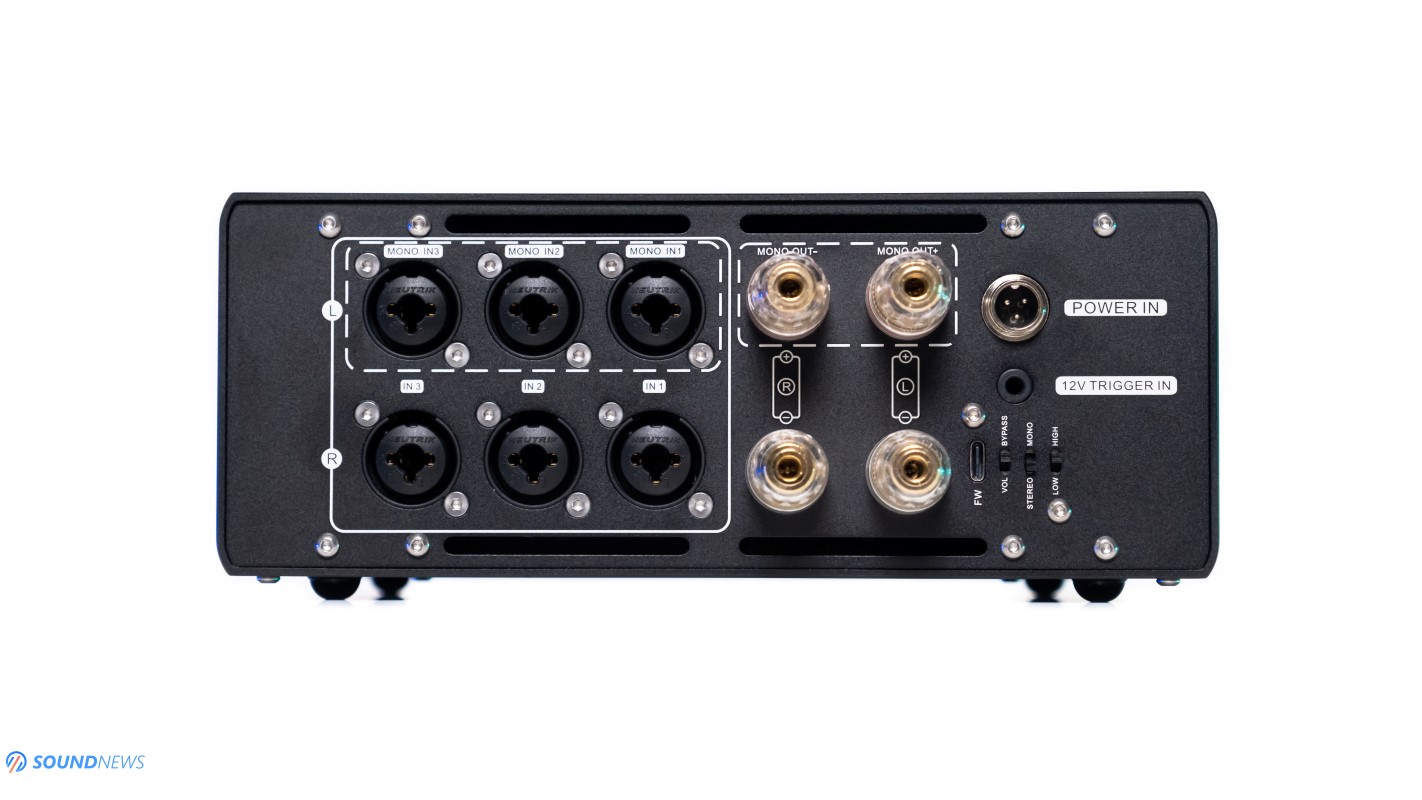
Controls & Connectivity
Topping designed it as a power amplifier first and as an integrated amplifier much later on and that’s the sole reason you won’t find remotes with this one. When working as an integrated, you can control its volume with that big volume wheel, otherwise stick with preamps that have remote controls. Besides its volume wheel, there’s a single On/Off button that works as an input selector too. Since we’re dealing with a balanced amplifier only, very much like my own Benchmark AHB2, you’ll find only XLR / TRS inputs on its back, two pairs of speaker terminals, a 3-pin DC power socket and several switches that lets you choose its gain position, its working mode (integrated or power amp) and a mono or stereo operation. Be informed that for mono mode, you will need two LA90 power amplifiers.
Benchmark added 12V triggers, just in case you’ll add another LA90, one of their DACs and Preamps, controlling everything with just a single remote.
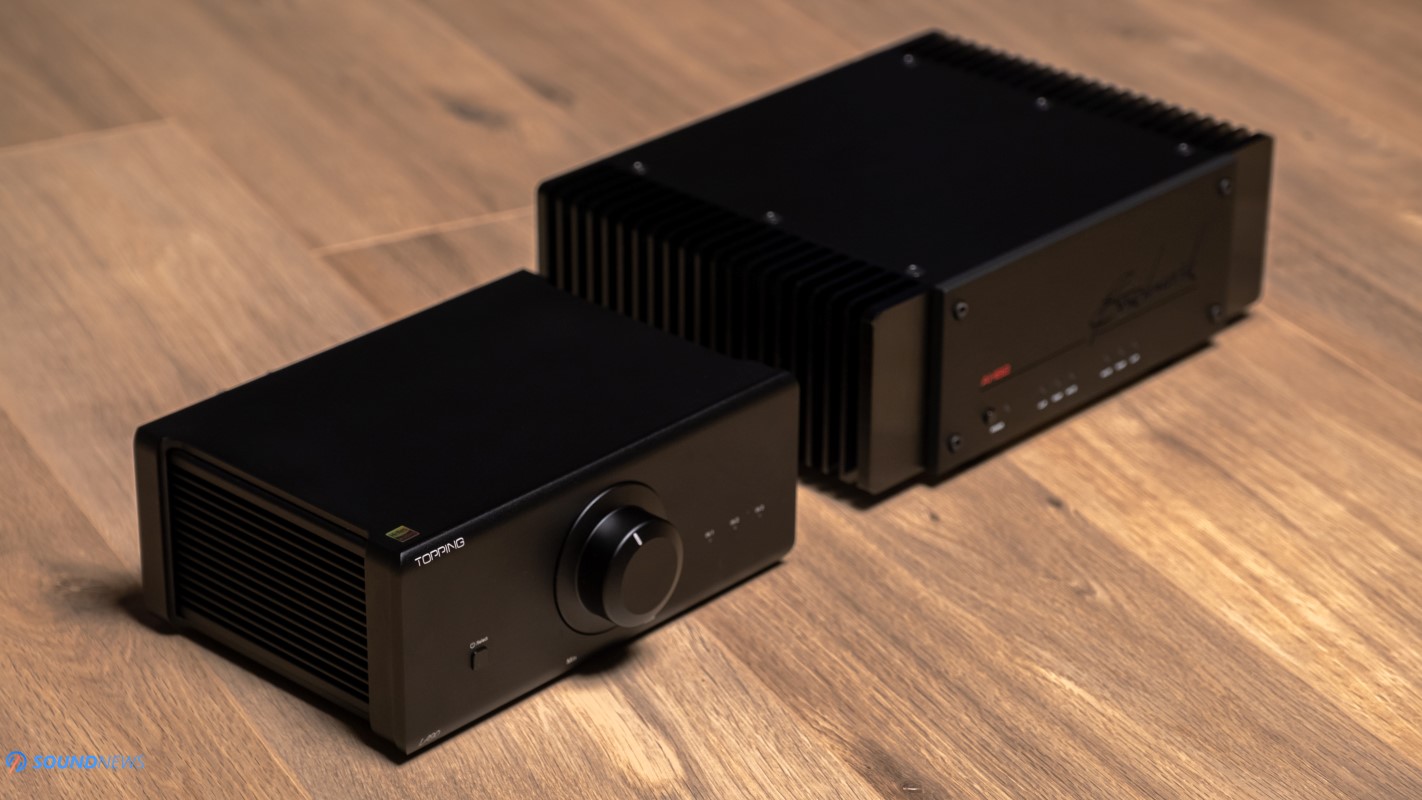
Under the hood of LA90
We are looking at a balanced only power / integrated amplifier, exactly how Benchmark made their AHB2 and I already feel a strong competition between these two. Please make sure to read until the end as I will be comparing both down to the smallest details.
In stereo mode it can work with either 4 or 8 Ohm loudspeakers and it will be providing around 90 Watts per channel in 4 Ohms and 50 Watts per channel in 8 Ohms respectively. If you bridge two units together, be cautious as it will work only with 8 Ohm loudspeakers or higher impedance ones, providing a much heftier output of 180 Watts per channel.
After toying around and switching from integrated to power amp mode, I’m getting a better performance when used as a power amplifier, controlling it with a dedicated preamplifier. Topping recommends using their PRE90 for the best results, the upcoming A90 Discrete will work the same way and if you already own any of their last generations DACs as D90 or D90SE, then you can hook them up directly to LA90 and get some outstanding results.
It’s worth mentioning that while it’s far from an over-powerful amplifier, LA90 has currently some of the most impressive specs and measurements. With a dynamic range of 140 dB in stereo mode and 142 dB in mono mode, it won’t be the weakest link in your chain as it usually happens with analog amplifiers, most likely your digital or analog source will get that title. Its channel crosstalk sits at -138 dB in stereo mode, so you can be sure that it will sound spacious and big, as long as your loudspeakers are fully driven.
Two gain settings are being provided: +10 dB at low gain and +20 dB at high gain and after playing around, it definitely sounds better on high-gain with all my sources, while providing a higher headroom with high dynamic range tracks. Topping wanted a similar width and depth with their D90SE and PRE90 units, for a beautiful audiophile package and for that to happen the only option they had was moving the power supply outside its case, going with an external switching mode power supply that outputs 64V and up to 4A of current (roughly a 256-Watt power supply), suggesting that LA90 works (for the most part) in Class AB. My iFixit Pro toolkit couldn’t deal with its rear plate, so I couldn’t have a peek inside, but my best guess is that we’re dealing with an op-amp based preamp stage, followed by a discrete transistor-based power amp stage (still waiting for a confirmation).
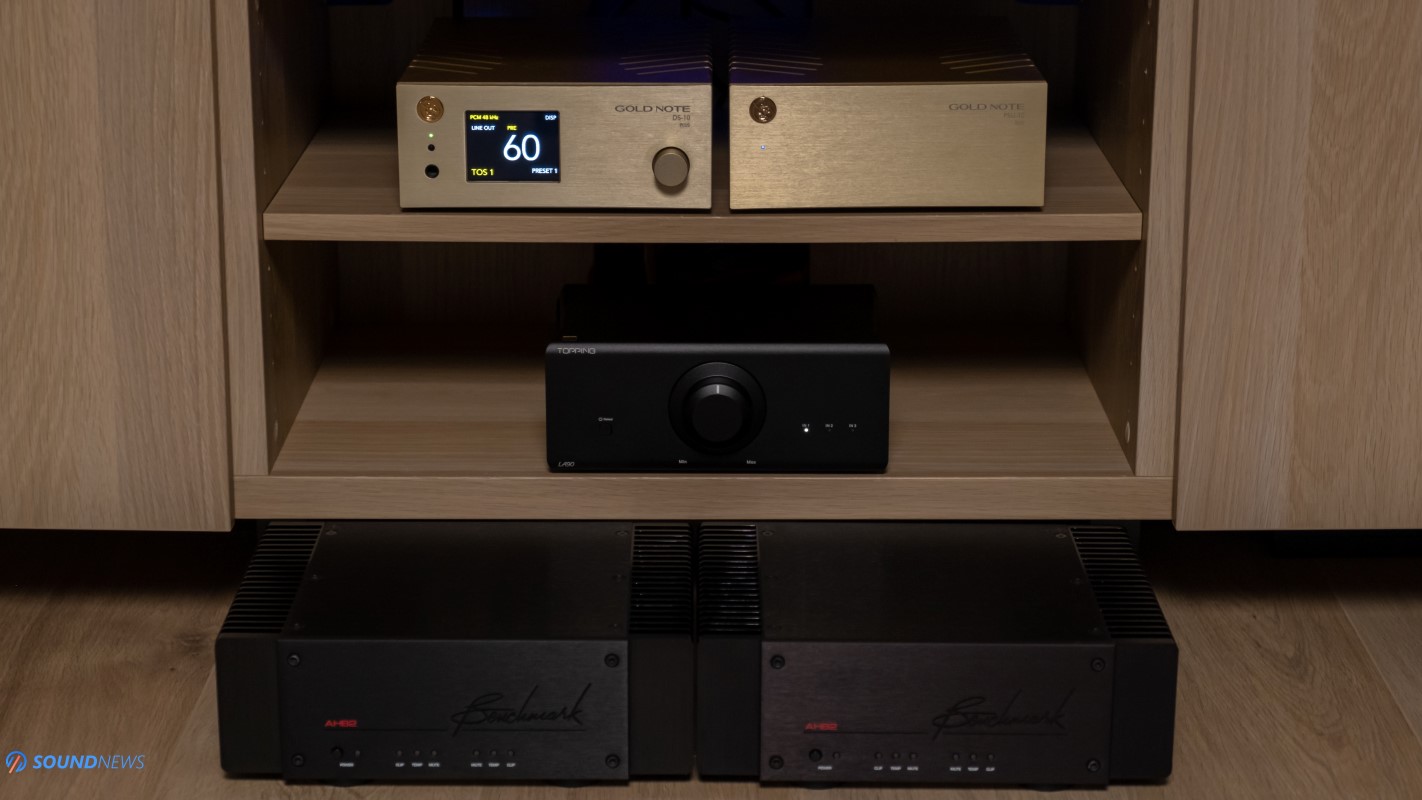
Test Equipment
Topping LA90 was used in a high-end stereo setup, mostly connected to a Gold Note DS-10 PLUS + PSU-10 EVO DAC, Preamp and streamer. However, it also worked with an Audiobyte HydraVox + HydraZap stack and with a Chord Dave for at least several days.
I wanted to squeeze the last drop of performance out of it and that’s why I’ve used two different loudspeakers: my daily driver KEF Reference 3 (€14.000) and Sound Of Eden Crescendo UNO (€2700) bookshelf loudspeakers. Okay everyone, enough with the talk, let’s hit some eardrums!
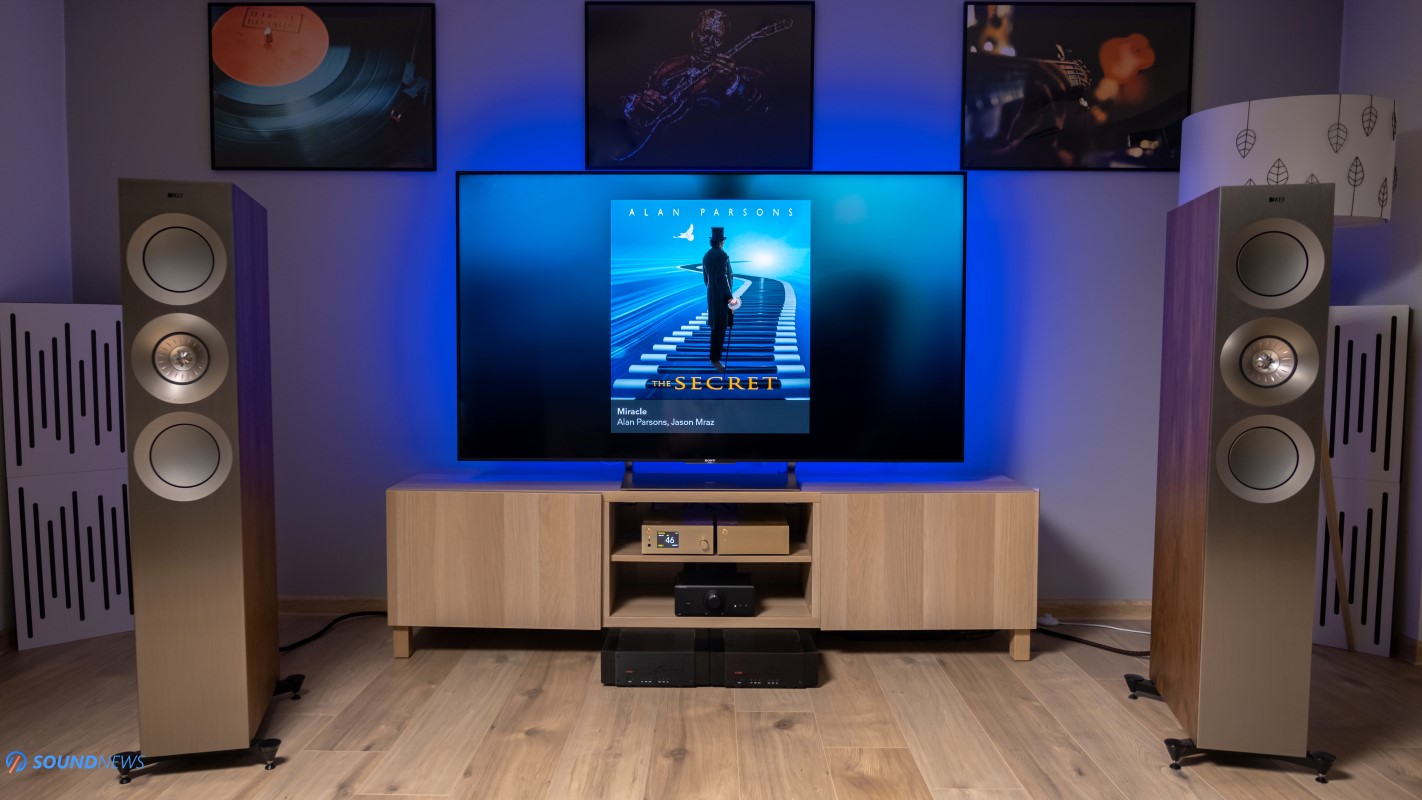
Sound Performance
I. Preliminary Sound Impressions
It seems that I have tried most, if not all Topping and SMSL integrated & power amplifiers by now, you can find most of them around here and I still remember their performance. After warming it up for about two weeks, several things stood out immediately to me:
1. Cleanness and resolution. Without a single doubt in my mind, I was experiencing one of the cleanest sounding amplifiers of the far-east countries. I moved to a Benchmark AHB2 about a year ago due to its resolute and ultra-revealing nature that completely wiped the noise floor out of existence. AHB2 removed remaining traces of noise and all that remained, was a transparent sounding amplifier that wouldn’t color my music in any way. As an audio reviewer, I need to heavily rely on my equipment, I need to have the cleanest possible signal without coloring the music, so I can distinguish the sound signature of a new DAC, amplifier or loudspeakers. Those were my main goals and AHB2 fully satisfied them. A single AHB2 was sometimes clipping with high dynamic range tracks, so I’ve got another one, bridging them together for some power-overwhelming action (380 Watts per channel in 8 Ohms). Topping’s LA90 tries to mimic AHB2’s sound at just a fraction of its cost, as I’m again hearing subtleties and low-level information that only AHB2 could provide up to this point
2. Transient Response. Topping LA90 was tightly controlling the drivers of my loudspeakers, always sounding nimble, keeping up with the most demanding tracks. This thing works very well with fast electronica tunes. Double drums didn’t pose a problem, as LA90 was made for this kind of music. There was a shorter decay of the notes compared to Class-A and Class AB amplifiers that passed through my hands and much shorter ones versus hybrid amplifiers. Sometimes I find it impactful sounding, sometimes not as much, but I’m sure for one thing: if you have a need to speed, LA90 will provide that to you without breaking a sweat.
3. Imaging. A single unit didn’t sound as spacious and airy as two AHB2 units sounded in bridged mode, but when it came to imaging…LA90 felt on top of its game, offering defined leading edges. It was never blurring the overall picture as it was highlighting the contours of the notes that were playing in the background. I heard the smallest nuances, even when musicians were inhaling and exhaling air from their lungs. The smallest intricacies were placed in individual air bubbles, never bumping into each other for a really nice imaging. At this price point…I was more that impressed.
4. Noise Floor. While Topping didn’t use Nested Feedback Composite Amplifier modules as they’ve done with latest generation headphone amplifiers, part of that knowledge found its way in the LA90 as no matter how high I was raising that volume, I couldn’t spot a higher noise floor coming from ultra-sensitive UNI-Q drivers of my loudspeakers. There wasn’t a single SMSL integrated or power amplifier that had an impeccable noise floor, always delivering a dirtier background with raw performance numbers, but LA90 is a very different beast, always sounding clean and noiseless.
Apart from the aforementioned points, LA90 wasn’t in any way coloring my music. If you’re coming from affordable Class-D amplifiers, then you’ll immediately feel a faster pace, a tighter and a deeper bass performance, without getting a thin ‘n shouty midrange. On the other side of the rope, LA90 won’t sound as organic, relaxed and mid-centric as Class-A amplifiers would do so bravely. With LA90, there’s a perfect blend of naturalness and technicalities and if you’re searching for a lot of soul and midrange presence, then sadly LA90 won’t tingle your senses, as we’re talking about a linear sounding unit, that won’t put an accent on a particular frequency range.
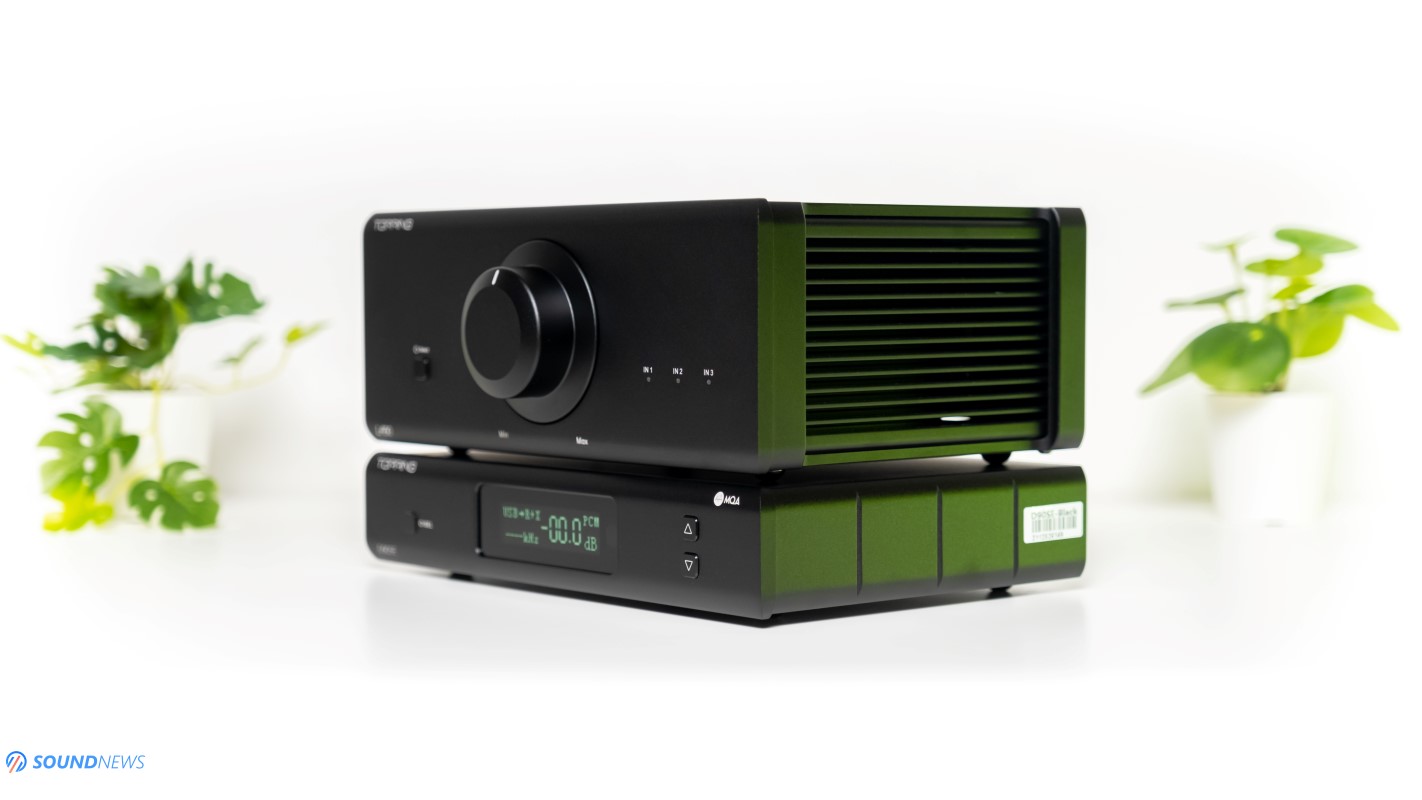
II. Power Output
The only chapter I can nitpick about LA90’s performance is this one. Sure enough, there is a substantial amount of power on tap, but it seems that my KEF Reference 3 need just a little bit more for higher dynamic swings. With most of my tunes, I was sitting in between 75 and 80 out of 100 with the Gold Note DS-10 Plus, but on rare occasions I could go up to 85, a point where LA90 started mildly clipping, adding small traces of distortion, arriving close to its peak power output. It needs to be said that Gold Note DS-10 Plus has an active preamplifier stage, that can push the voltage a little higher to the industry standard and if I would use a passive preamplifier, then I would surely arrive at its maximum volume for the same SPL I was getting from DS-10 Plus. However, if you aren’t listening at ~90 dB levels, then a single LA90 unit should be more than enough.
Sound of Eden Crescendo UNO might look as a regular bookshelf loudspeaker, but rocking ceramic drivers, a lower 4 Ohm impedance and a lower sensitivity of 85 dB (similar to my Reference 3), I was getting deja-vu levels of performance. I clearly remember that UNO sounded better with two AHB2 power amplifiers, as a single unit wasn’t delivering crazy dynamic swings and it seems that I’m getting a similar story with a single LA90 unit. These sounded good to almost great with LA90, but I wasn’t getting that imposing, powerful and deep bass performance that UNO’s are known for when unlimited power levels are flowing through them. With all that said, if you aren’t going up as loud as I do, then you should sleep tight as a single LA90 would provide all the power and control you can think of.
Regardless of how much power was remaining on tap, LA90 was tightly controlling the drivers and it never felt out of place. It wasn’t lifeless or thin sounding, as I found it toe-tapping with most of my tunes. I couldn’t make my windows dance to the rhythm of the music and my neighbors weren’t knocking at my front door, but do we really need ear-deafening sound levels in a flat? All in all, there was enough power on tap, but not as much as its competition would provide. You should make up your mind, are you after a clean & noiseless power or are you after brute force that lacks refinement, while hiding micro-details in the background. As for me, give me a low-power, but ultra-clean sounding amplifier any time of the day.

III. Noise Floor
I’m a little sad that Topping isn’t spilling the beans on how they’ve dealt with the noise floor, as clearly something is stopping it from reaching the speaker taps of my loudspeakers. Looking at its spec sheet for one last time, you’ll observe that we’re dealing with an impressively low noise floor, sitting at just 3.5uV on high gain, that’s usually reserved for headphone amplifiers. Modern integrated or power amplifiers have it in between 10 and 20 uV (AHB2 has it at 7.1uV in stereo mode and ~10 uV in mono mode) and older ones can reach a noise floor of almost 50uV.
It’s almost pointless telling you how hard I’ve tried unearthing its noise floor with my loudspeakers. I’ve went all the way up with music on pause and still, UNI-Q coaxial drivers were dead-silent as Muscovy ducks. When music started playing, I’ve experienced a pitch-black background that’s usually reserved for top-tier amplifiers. LA90 was fighting noise ferociously and it was so effective at it, that you’ll never experience a dirty background, unless your music was recorded that way. It was dead-silent with my digital sources, there weren’t traces of noise at any volume levels and that shouldn’t come as a surprise considering all their current production amplifiers. When noise goes out of the picture and distortion is no longer an issue, everything that remains is your unspoiled music, shown in its full glory. With LA90 at my side, I know that I’m squeezing the full dynamic range of my setup, delivering the cleanest possible signal to my loudspeakers. It is so much easier doing DAC, preamp and loudspeaker reviews with a unit like this at my side and it isn’t only a very good amp when music starts playing, but an invaluable tool when assessing new gear.
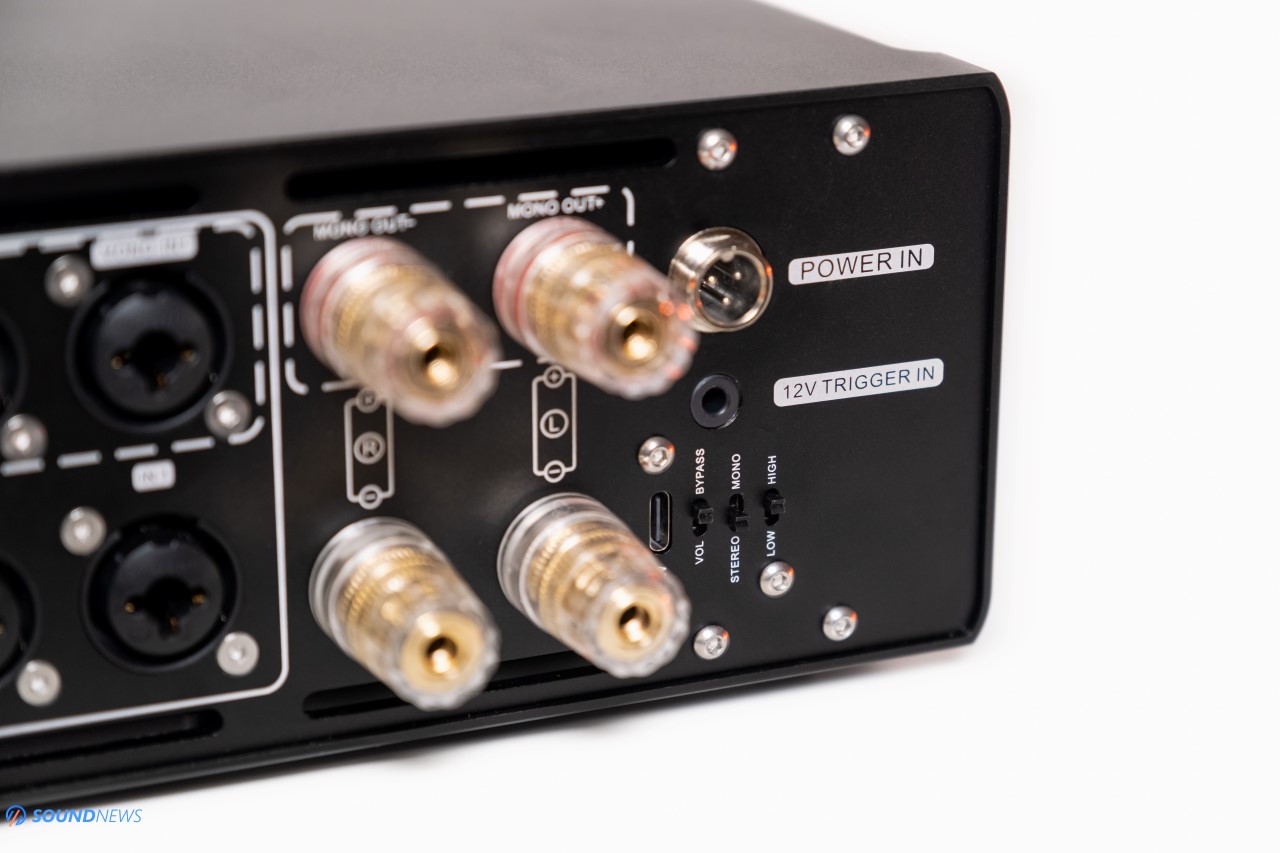
IV. Transient Response
Even without going through a long playlist, LA90 was refusing to hit the brakes with faster paced music, always going past the speed limit with modern pop or electronica. It’s nimble approach to music reproduction was a blessing with a lot of my tunes, as even older blues felt fresh and interesting to listen to. While LA90 might be a champion in the lightweight category when delivering speedy jabs, it wasn’t the most impressive kicker when bass notes were landing on my chest. LA90 keeps up with AHB2 levels of speed and control, but it won’t reach the same levels of slam and impact in the lowest octaves. After several low-level listening sessions, it revealed itself as calmer sounding, maybe too polite for the music that was playing in the background. It didn’t bring the thunder and it wasn’t reaching higher dynamic peaks. While we’re talking about high-quality bass levels, it was hardly reaching the lowest octaves, mildly impressing me with a limited low-end extension. This is indeed the highest performing amplifier coming from China that I’ve tested up to this day, but it wasn’t as fearless and bold sounding as proper Class-AB amplifiers sounded before it. KECES S125, S300, Kinki Studio EX-M7 and Benchmark AHB2 were kicking with a higher force down low and delivered a longer sustain with tunes like Teardrop or Angel by Massive Attack (Qobuz / Tidal).
I can only presume that a limited power output and current delivery is somehow stopping my Reference 3 from reaching their fullest potential. I know how impressive these babies can sound with electronica tunes, sadly that isn’t what I’m hearing with a single LA90. Our local Topping distributor didn’t get the newest LA90 shipment and I can’t find another unit for some dual-mono action, but I will be surely editing my article once a secondary unit hops on board.
Chocolate Chip Trip is still an invaluable Tool (Qobuz / Tidal) when assessing new gear, as it always rushes dopamine and puts me in a good mood thanks to legendary drum solo towards the end. LA90 entered the arena immediately, but it wasn’t delivering the thump that I was desperately searching for. Something didn’t find its target, as I couldn’t feel the full force behind snare drum hits and double drums. Something was stopping from reaching the full potential of this track, as clearly LA90 wasn’t up there with upper-echelon amplifiers as AHB2.
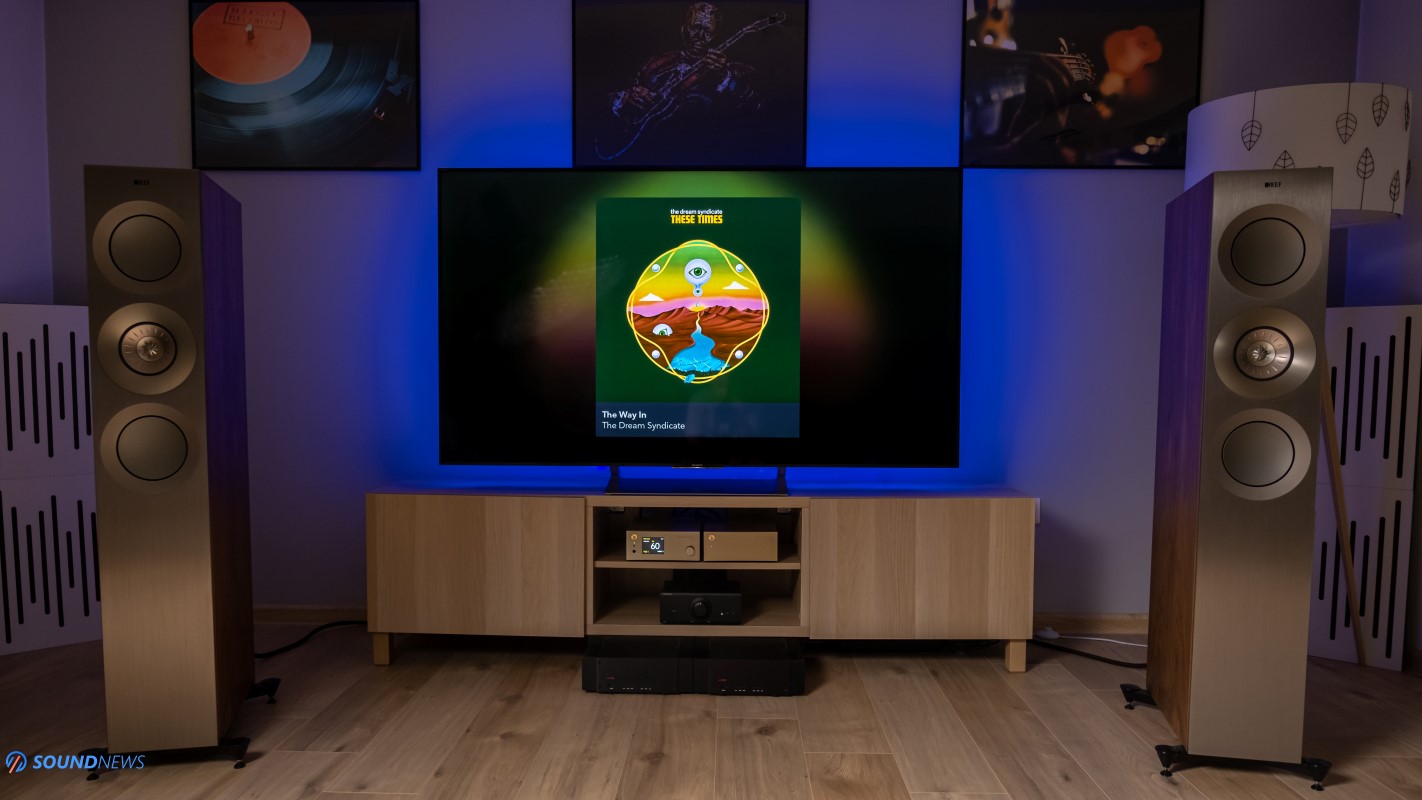
V. Transparency & Resolution
I will surely nitpick about its limited power output and less than perfect bass extension, but when it comes to transparency and resolution, then LA90 is literally up there with the best I’ve tried. You know, getting clean and noiseless power is some of the biggest challenges audio designers are facing when designing such units, but knowing how clean and dandy their PA5 was with my speakers and remembering my past experiences with their NFCA headphone amplifiers, I would be surprised if I wouldn’t get an ultra-revealing type of sound.
A lot of folks are associating clean sounding units as clinical or even harsh sounding, but that wasn’t really the case with Topping devices. While it would surely bring up every single detail and nuance that’s hiding behind your tracks, it wouldn’t deliver a clinical performance with treble-intensive tracks. As long as you aren’t reaching its peak power output, LA90 will sound as if it doesn’t exist in your acoustic chain, mimicking the sound of your source and loudspeakers, without leaving a stain or coloration. LA90 does remind me about their A90 headphone amp and about my own AHB2 power amp that goes with a similar tuning, making sidesteps and leaving the music flow directly into your eardrums, without altering the signal’s purity.
LA90 is as colorless and as linear as power amplifiers could ever be and in this regard, I’m placing it at the highest levels together with the Benchmark AHB2, as transparency and resolution incarnate. As it was the case with AHB2, you’ll most likely be limited by the signal-to-noise ratio of your source and not of the LA90.
A few days ago, Warner Records released a Remastered 24bit/192 kHz version of Money For Nothing by Dire Straits (Qobuz / Tidal) – a compilation of some of the best songs from the first five Dire Straits studio albums and it seems that I found a perfect candidate for LA90. Immediately after hitting play…I felt utterly disappointed by the lack of dynamic range and finesse. The sound was cramped and two-dimensional, with little to no depth at all! This isn’t the LA90 that I know and surely not the Dire Straits that I grow up with, so I moved back to the original studio albums. Lo and behold! Dynamics returned back home, so many subtleties rushed in, I was finally hearing and feeling the music with the entirety of my body. LA90 immediately blamed the botched 2022 remaster, which sounded more like a 128 kbps mp3 file than like a veritable 24bit/192 kHz lossless recording. LA90 picked the original master in split seconds, thanks to its clean ‘n revealing nature. Please skip the 2022 remaster…it’s a disgrace to the original which sounded clearer, a hundred times more engaging and fun.
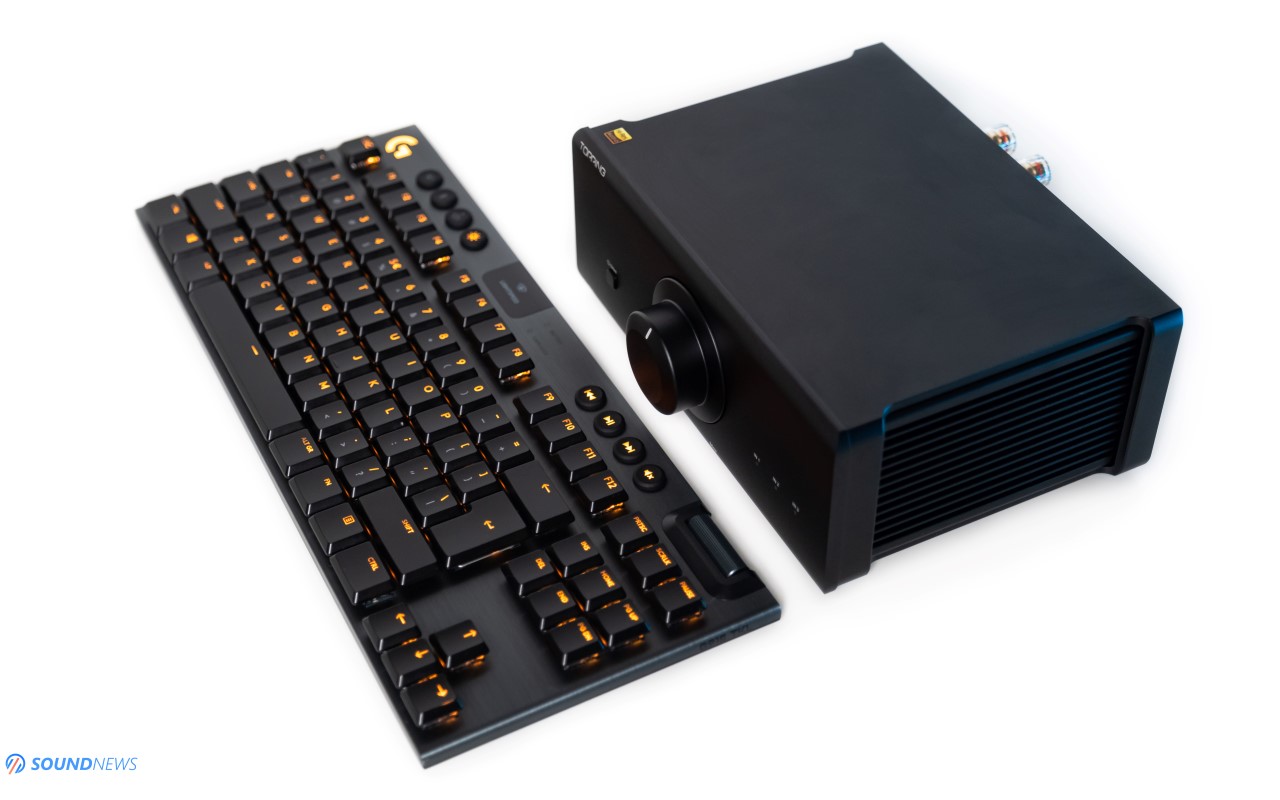
VI. Imaging & Soundstage
LA90 offers defined leading edges, you can feel the body of every musical instrument, their weight and air that was brought to the room. When an amplifier draws sharper contours of the notes, it lets you focus much easier, without closing your eyes shut. On well-mastered music, everything was floating nicely in the air, every note was precisely placed around me, as LA90 was imaging like crazy with either Reference 3 or Crescendo UNO. My room was increasing its size with live tunes, as if the music had no boundaries. When I moved to cozier recordings, made in smaller recording studios, the soundscape was slowing shrinking its size, placing me on stage with the musicians.
LA90 is not one of those amplifiers that will artificially boost the soundstage size on all axes, rendering it closer to the original intent of the mastering engineer. If the record was intended to sound big, wide and deep, then by all means, LA90 will sound that way and vice-versa, it will be close and personal with smoky old jazz. Crescendo UNO were refusing to sound small and dull thanks to their working principle and massive radiator on their back, moving enough air towards my listening spot, improving depth and ultimately the stage size. Instead of sounding cluttered and closed-in, both loudspeakers were placing the sounds exactly where they belonged, without overlapping them on top of each other.
While LA90 offers a precise location of the notes all around you, it will not thicken the air, nor add layers and sub-layers of sounds, as bigger and heftier amplifiers would do. When it comes to the sheer scale of the music, it won’t outperform my former Class-A and Class-AB amplifiers, even AHB2 sounded a little bigger and airier, but it will surely outplay entry to mid-level Class-D amplifiers anytime of the day. I’m pretty sure that with two units (working in mono mode), I would get different results, since there would be more power on tap and a zero channel crosstalk.
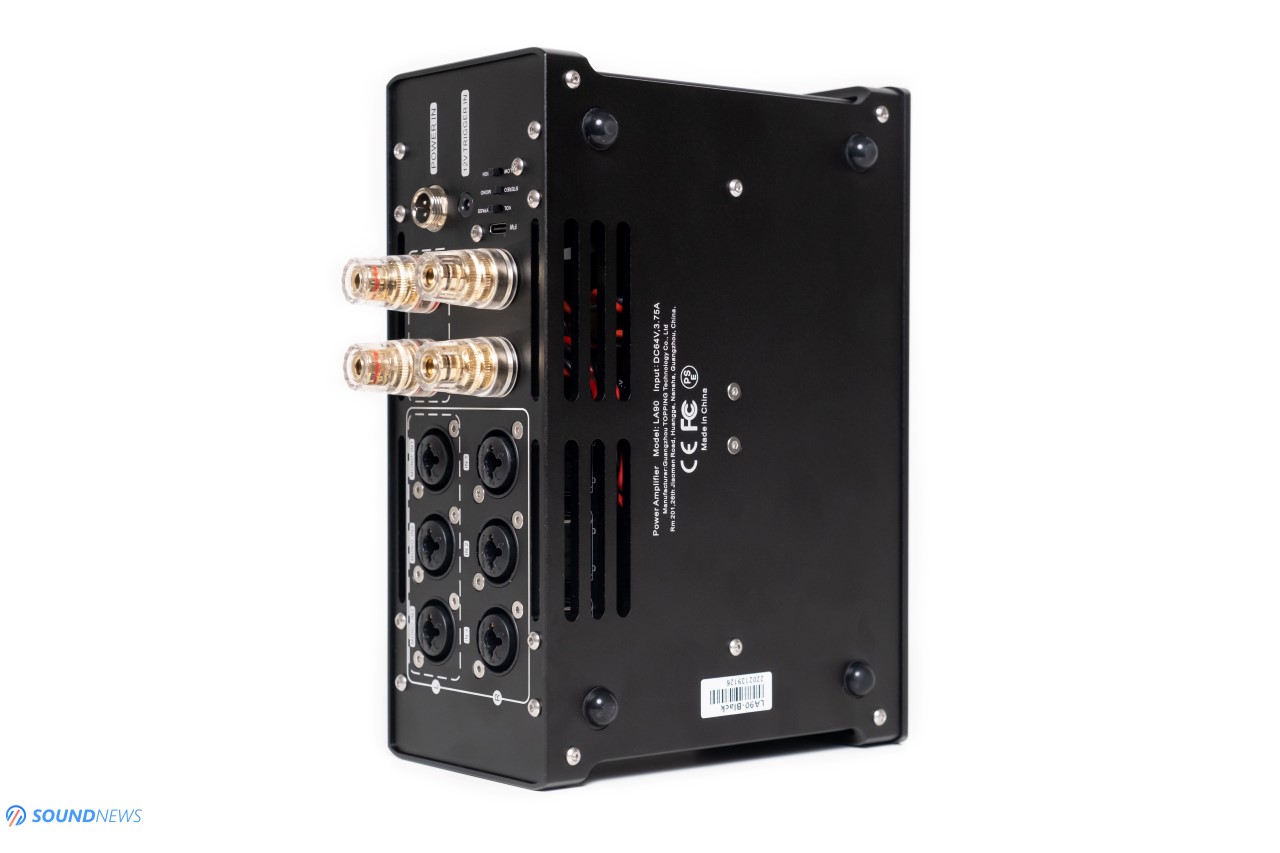
VII. Frequency Response
A. Bass
Finally, I’ve arrived at a relaxed chapter, as LA90 is a linear sounding unit, providing a straight line from the lowest octaves to the highest levels of treble. While we’re dealing with a tight and controlled bass performance, the sub-bass wasn’t going subterranean, only scratching the surface of the lowest octaves. I wanted a little more energy and heft in there, as otherwise it has everything to impress an audiophile with its clean, defined and fast sounding bass notes. If you love a detailed, accurate and lighter weight bass, then LA90 will impress from the first seconds. When Cactus by Pixies (Qobuz / Tidal) started playing, the starting drums didn’t rush a healthy dose of dopamine into my blood stream, I felt mildly engaged in the act, but not fully satisfied. When I moved to electronica, I had all the mid-bass presence and impact, but again, the lowest notes weren’t tingling my senses, missing some fun and leading to an accurate, but ultimately lightweight bass performance with both my loudspeakers.

B. Midrange
Midrange had the right tonality from the get go, human voices felt real and imposing, there was naturalness in old smoky jazz recordings and I felt raw energy oozing from my old rock tunes. Everything was at its place and from my perspective, midrange had the right dose of cleanness and naturalness. It wasn’t the smoothest nor the most believable sounding midrange, but it felt that way when comparing it with lower class SMSL amplifiers like AO200, DA-9 and SA400. There was more flow and effortlessness on the Topping unit, pushing the vocal performance a little closer to the listener. By comparison, even AHB2 felt by a hair drier sounding in here, which came as a small surprise. I’m reminding you that I’m describing a linear sounding amplifier, that will get out of the way, leave your music unspoiled and as transparent as humanly possible. There is none of that mellow or slow sounding midrange, as again we’re dealing a sports car disguised as a power amplifier.
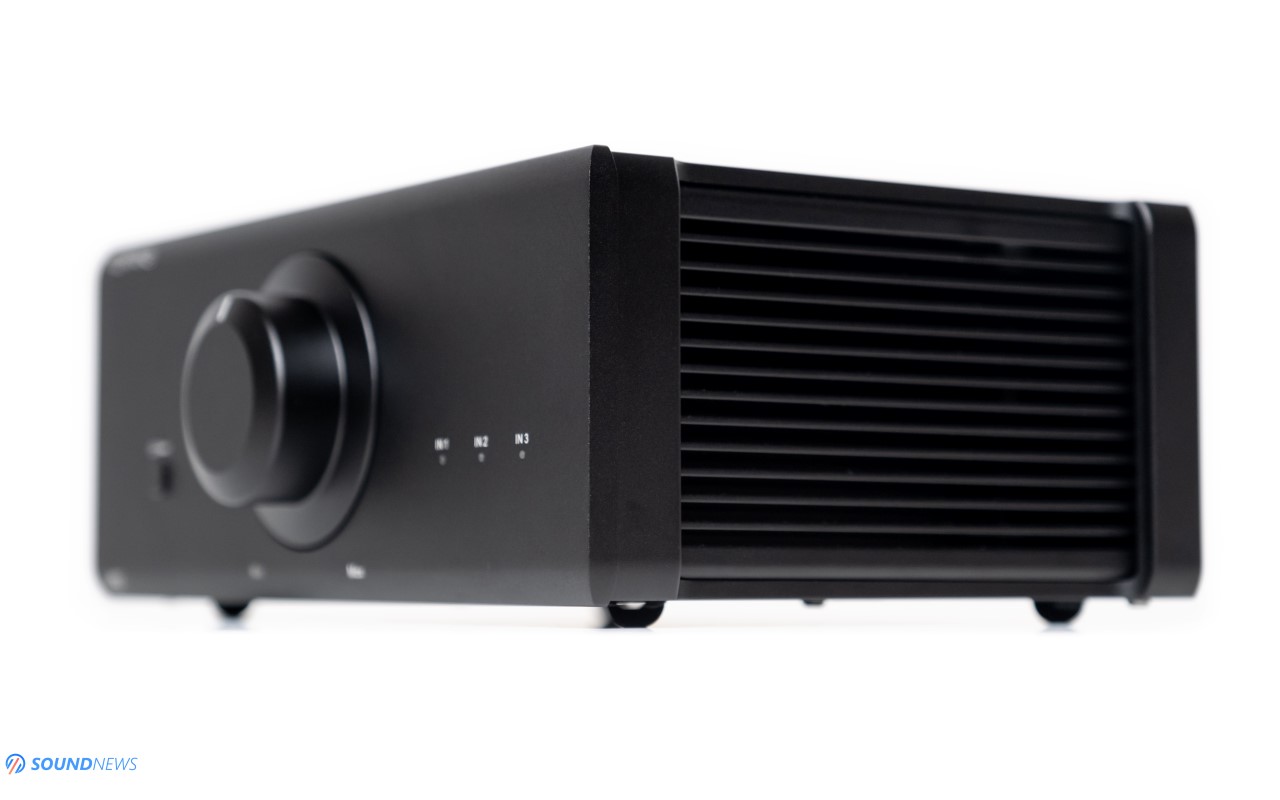
C. Treble
Treble felt clean, defined and extended, easily reaching the top octaves, without becoming a burden. Luckily, it didn’t bring a higher treble energy, pairing nicely with their D70S, D90 MQA and D90SE without altering their flavor. LA90 wouldn’t increase treble energy, nor would it limit it in any way. While sharp and defined on tracks filled with tambourines, bells and cymbals, it was never sibilant or edgy sounding. Imagine a clean treble delivery, without sacrificing detail, texture and naturalness and that is how LA90 sounded to me.
Overall, I consider it having an almost perfect frequency response, being extended in the top octave and less so in the sub-bass, dragged down by a less than a perfect sub-bass definition and heft. More importantly, it offered a good tonal balance without becoming fake or bright sounding.
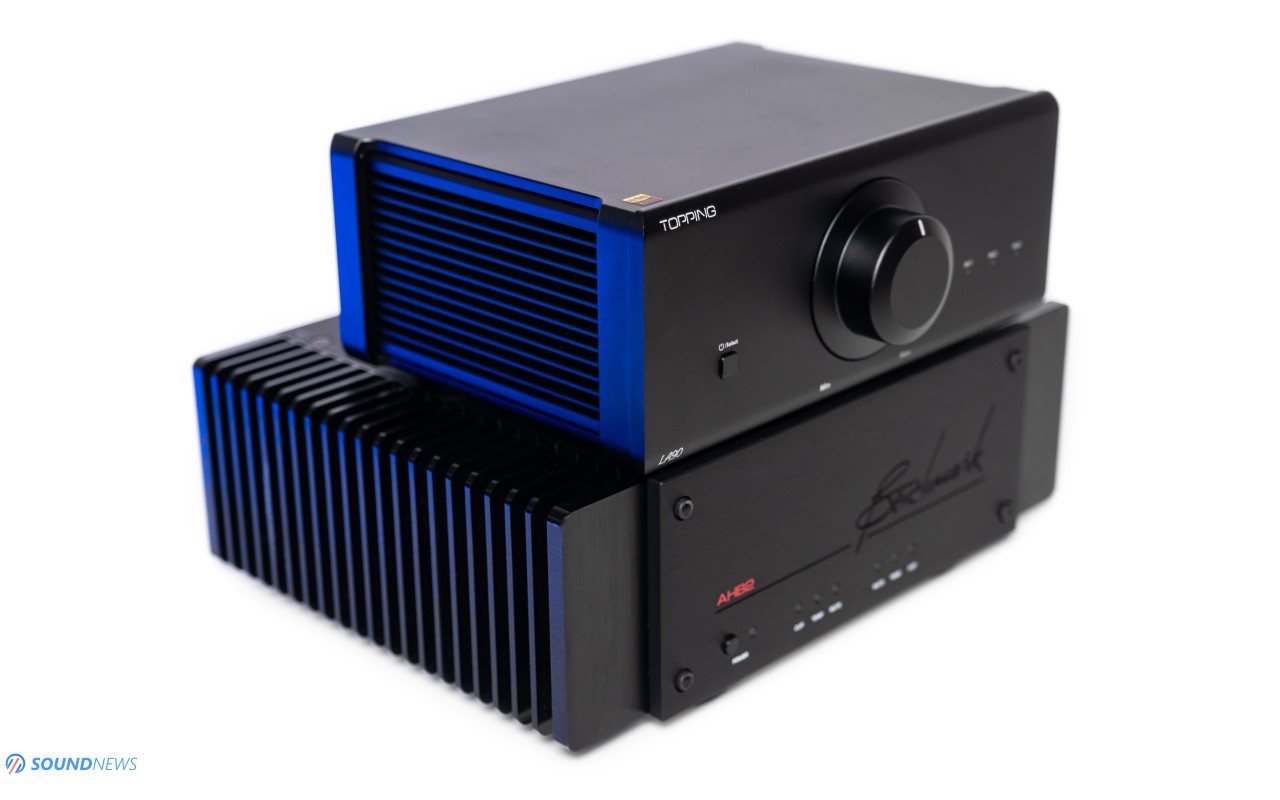
VIII. An Important Comparison
Topping LA90 ($899) VS Benchmark AHB2 ($2999)
Someone called the LA90 as an AHB2 killer thanks to its impeccable measurements, but since we are listening to music via our hearing apparatuses and not with an Audio Precision APx555 audio analyzer, an objective comparison seems to be more important. Instead of sine waves I will be using music and on top of that, we are (still) better at discerning things as timing, depth and scale of the music.
Firstly, let’s get the facts straight. AHB2 provides 100 Watts in 8 Ohms versus 50 Watts on LA90 and 190 Watts in 4 Ohms versus 90 Watts on LA90. It is roughly two times as powerful and it feels that way when music started playing. For a 90dB SPL in my listening room, three meters away from my loudspeakers, I needed to raise the volume on my preamp to around ~70 (out of 100) with the AHB2 and I needed to go to around ~78 with the LA90 in its place. When LA90 was clipping with high dynamic range tracks, AHB2 was still running cool, providing a higher headroom with difficult loads.
Apart from this, AHB2 is equipped with nine bullet-proof protection systems as: temperature protection on each output channel, temperature protection on its main power supply, over-current protection on each output channel, over-voltage protection on each output channel, DC offset detector on each output channel, SOA (Safe Operating Area) detector on each output channel, load sensor on main power supply, fault sensors on all power supplies and AC line under-voltage fault sensor on AC input. Fault conditions silently mute both output channels in order to protect the speakers and amplifier from any damage. Only by looking at the specs and protection systems that are missing on the Topping unit, LA90 is hardly a AHB2 killer if you ask me, a AHB2 tickler…maybe?
After carefully volume matching both units at less than 0.5 dB of difference, I sat down for a long listening session and unsurprisingly, LA90 can still challenge the AHB2 on so many things. I couldn’t tell which is which when it comes to noise floor and detail retrieval. I find them equally impressive in here, always delivering the purest version of my music, without intervening in any way. Both were putting absurd amounts of information of the foreground, whilst trying to disappear from the acoustic chain. I could easily discern low-grade from top-grade recordings and sincerely, both were going for a neutral and transparent reproduction of my music.
When I moved to modern tracks, there was a clear difference in favor of the AHB2, that wasn’t limiting the sub-bass delivery. AHB2 felt more impactful and alive in the bass. LA90 was shier by comparison, limiting the sub-bass delivery and ultimately bass extension and dynamics. Maybe, there would be a different result with two LA90 units versus a single AHB2, but sadly I can’t find another LA90 nearby. When sub-bass is slightly limited and subdued in its delivery, the sounds wouldn’t take off and fly away into the abyss, as LA90 felt smaller and cozier sounding by comparison. A single AHB2 was breaking the boundaries of my room with live records, but LA90 wasn’t as airy and holographic sounding.
LA90 borrowed some of the best parts from the AHB2, it came dangerously close on several aspects, but it won’t outperform it in a direct comparison. LA90 was impressive on its own when it came to noise rejection, speed, driver control, cleanness and transparency and considering how affordable it really is, I presume a lot of folks will be rocking a pair of LA90 in their living rooms.
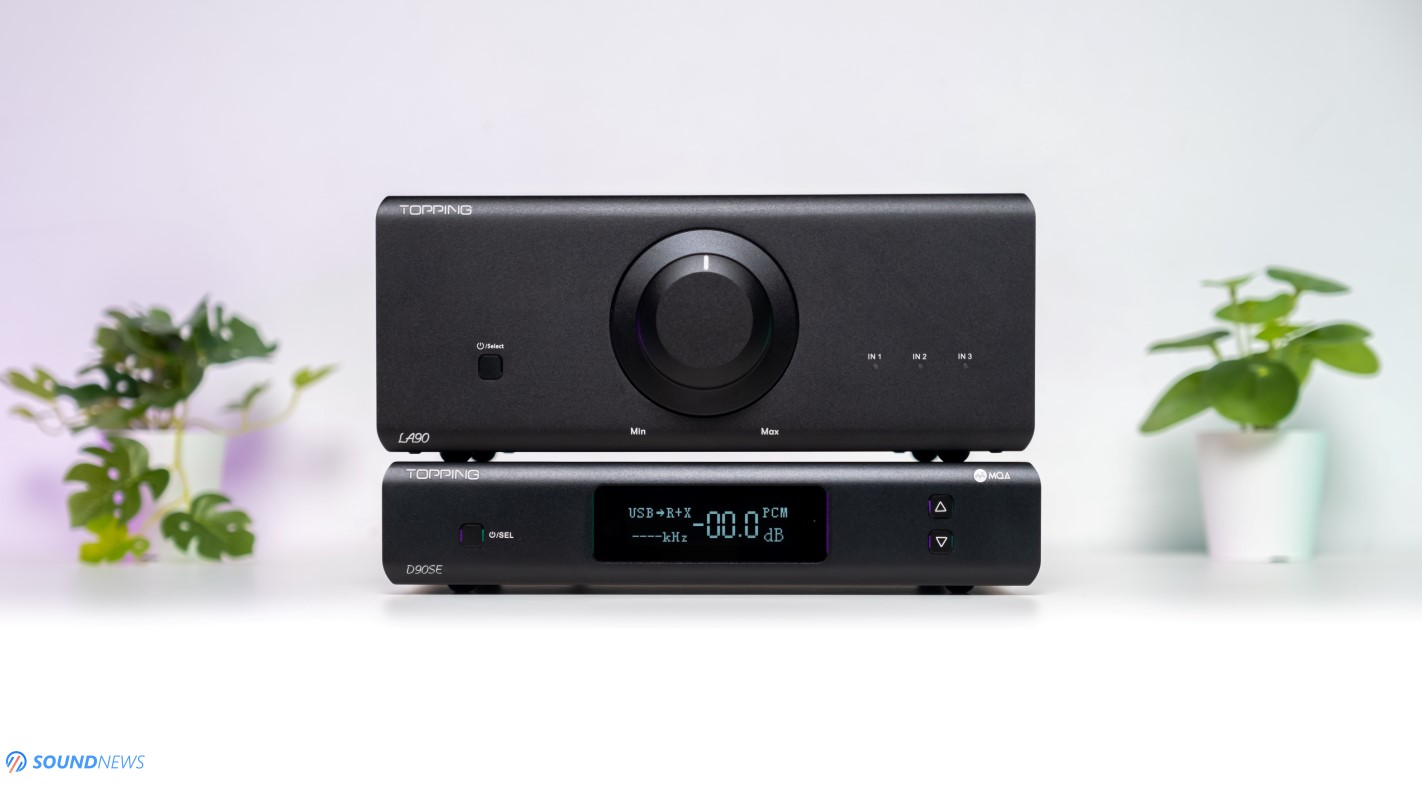
My Conclusion
Several red flags arose when I started unboxing it. I still dislike its massive and heavyweight external switching mode power supply and if you’re using an audio rack, it would be a challenge hiding it behind your cables. In mono mode it can work only with 8 Ohm loudspeakers and that’s a missed opportunity as under load, most 8 Ohm loudspeakers will lower their nominal impedance to 3 or even 2 Ohms, limiting the dual-mono functionality of the LA90 to only a handful of passive loudspeakers. It won’t sugar coat or beautify your music, it won’t add smoothness or liquidity into the mix and it surely won’t be for everybody.
If my concerns aren’t that important to you, as you’re rocking higher sensitivity speakers, then for the love of Odin, you’re looking at one of the cleanest sounding amplifiers I put my hands on. I was beyond impressed when DSD and Hi-Res files started playing, performing as a wire-with-gain amplifier that never stood in the way of my music. LA90 is a highly technical sounding unit that removed all remaining traces of noise. There are still a few things to like about this one and for all of the reasons combined, it fully deserved a Silver Award from yours truly.

Topping LA90 will set you off $899 and that’s a fair price considering its technicalities and overall performance. It was kindly provided by the fine gents of Apos Audio and it can be purchased from their web-store by following this link. (They still offer free shipping in the USA and Canada, free 45-day returns in case you don’t like it, an extra year of warranty and the lowest price guarantee). In case you’re getting one, please let me know in the comments section below if it nicely drives your loudspeakers.
PROS:
- Minimalist & sleek looking amp
- Lightweight and small enough to be used in tiny setups
- Runs cool even under heavy loads
- Impressive selection of analog inputs (3 pairs or XLR/TRS inputs)
- There’s a decent amount of power under its tiny hood, but if you need more – you can always add another unit
- Extended frequency response
- Lacks any form of noise or distortion, extremely transparent sounding
- Clean and highly detailed at all times
- Fairly neutral sounding, without putting an accent on a particular range
- Accurate positioning of the notes around the listener, excellent imaging
- Lightning-quick transients
- A technical sounding amplifier on all accounts
- Worth its asking price
CONS:
- It’s a balanced only amplifier, you’ll need special adapter cables (RCA to XLR) for your single-ended only sources
- Lacks oomph and punch, not that impactful
- Quite ethereal sounding, lacks sub-bass extension,
- Soundstage and depth weren’t that impressive, it’s two-dimensional sounding
- Won’t provide unlimited headroom and power, would clip with low-sensitivity speakers
- In mono mode (bridged) it won’t drive 4 Ohm loudspeakers
- Lacks a remote control to be used as an integrated amplifiers
- It’s a challenge hiding its external power brick behind an audio rack
ASSOCIATED EQUIPMENT:
- DACs: Audiobyte HydraVox & HydraZap, Chord Dave, Gold Note DS-10 Plus & PSU-10 Evo
- DAPs: Hiby RS6, R5 Gen2, FiiO M17, M11 Plus ESS, Shanling M7
- Headphone Amps: Trafomatic Primavera, Trafomatic Head 2, Enleum AMP-23R, Ferrum OOR + Hypsos, Flux Lab Acoustics Volot, Burson Audio Soloist 3X GT, several Topping, SMSL & Gustard units
- Preamps: Musician Monoceros
- Integrated Amps: Topping LA90, Enleum AMP-23R, Burson Timekeeper 3i
- Power Amps: Topping LA90, Benchmark AHB2 (x2)
- IEMs: FiiO FH9, FH7, FA9, FD7, Meze Rai Penta, LittleDot Cu KIS, Kinera Skuld, 7Hz Timeless &others
- Full-sized headphones: Hifiman Susvara, HE1000SE, Arya Stealth, Audeze LCD-5, LCD-4, Erzetich Phobos V2021, Phobos V2018, Erzetich Mania, Sennheiser HD800S, Kennerton Rognir, Gjallarhorn, Vali, Apos Caspian, Sendy Peacock, Apollo, Aiva & others
- Loudspeakers: KEF Reference 3, Sound Of Eden Crescendo UNO
- Interconnects: QED Reference (x2), Topping TCX1 (x2)
- Speaker cables: Kimber PR8, Audioquest Type4
- Power Cables: Isotek EVO3 Premier (x3), iFi Audio SupaNova (x2)
- Balanced Isolation Power Conditioners: PLiXiR Elite BAC1500 (stereo setup), Elite BAC400 (headphone setup)







